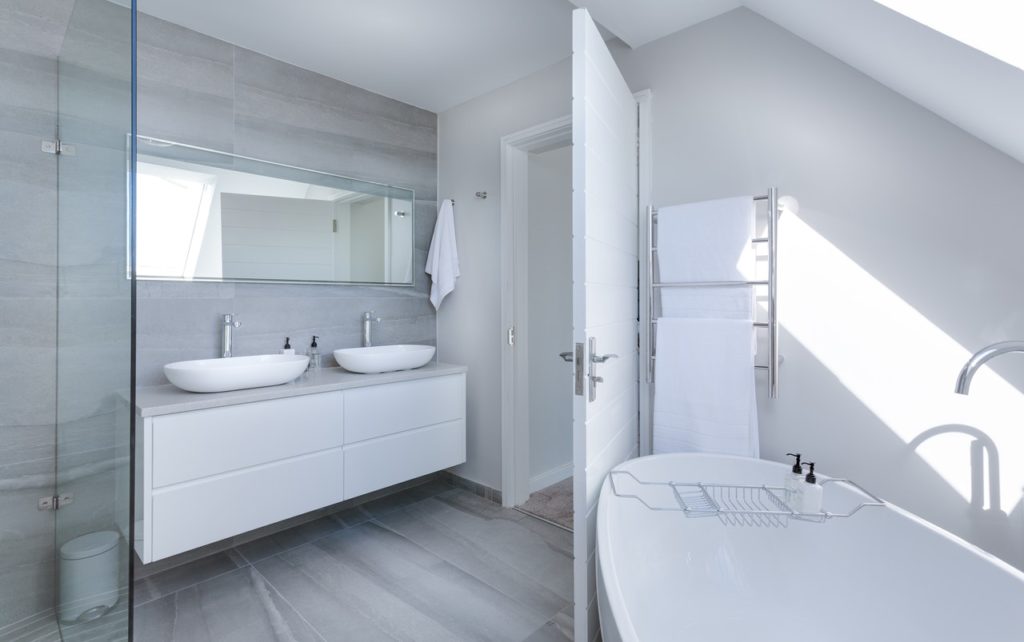Bathroom renovations aim to increase bathroom longevity and utility. So, why not hit two birds with one stone and beautify your bathroom while saving the environment? Whether your bathroom needs a total makeover or you need to change fixtures, there are eco-friendly options you should consider. Below is our recommended eco-friendly bathroom makeover.
Ecological Bathroom Overhauls That Will Please You and the Environment
Find a Reliable Contractor
Renovating your bathroom is a rewarding experience but is often too complicated for individuals not used to doing home renovations. If you’re one of those people, consider employing home remodeling contractors such as Serenity Kitchen and Bath. Just tell them you want an eco-friendly bathroom, and you’re set.
Start with an Eco-friendly Interior
Bathroom beautifications aren’t complete without appealing aesthetic improvements. From tiles to bathtubs, there are eco-friendly options that are both functional and beautiful. We recommend changing your bathroom tiles to recycled tile. Not only are recycled tiles environmentally friendly, but they also come in various shapes and designs that’ll suit your taste.
If you’re planning to include a bathtub, choose steel bathtubs instead. Traditional bathtubs are made from fiberglass and acrylic, both hard to recycle and fragile—often, fiberglass bathtubs only last for ten years. Steel bathtubs, on the other hand, are durable and completely recyclable. Plus, steel bathtubs can keep hot water longer, checking off energy savings in our eco-friendly goal.
Last but not least, use solid wood or reclaimed materials when building your cabinets. Bamboo cabinets, for example, complement your bathroom’s earth-friendly aesthetic.
Switch to Energy-efficient Fixtures
One of the most effective ways to help the environment is to keep energy consumption to a minimum. That’s why you should switch your bathroom fixtures to energy-efficient equipment. Thankfully, there are a plethora of choices you can choose from.
Often in homes, water heaters have the highest energy consumption. Consider switching to a tankless water heater, which only heats the water you use; a solar water heater, which uses energy from the sun for its energy consumption; a condensing water heater, which uses an advanced heating technology that consumes less power; or a heat pump water heater, which uses extracted heat from the air plus its heat refrigerant to heat the water. By choosing any of these four water heaters, you can save energy and lessen your electricity bill significantly.
Next, use energy-efficient light bulbs. While incandescent bulbs are being phased out nowadays, some homes still use them. If you’re still using incandescent bulbs, it’s time to switch to LED light bulbs. If you’re looking for elegant lighting, consider installing a solar tube or a skylight. These lighting options use natural light to illuminate the room.
Reduce Water Consumption
Your bathroom obviously has the highest water consumption in your house. However, that doesn’t mean we can’t reduce it. We can start reducing water usage by using the Environmental Protection Agency’s recommended equipment. Take note that the EPA classifies water-efficient appliances by labeling them with WaterSense. Remember to check for this label when buying any equipment that uses water. From that information, we can now easily find a water-efficient toilet, showerheads, and faucets. When choosing your next toilet, consider using a toilet with a mounted sink. These toilets conserve water by using water you used to wash your hands as the water to flush your toilet with.
Another piece of equipment you should consider changing is your showerhead and faucets. After all, traditional showerheads and faucets use about two to three gallons of water per minute. Hence, choose a WaterSense labeled showerhead or faucet for your bathroom. If you’re undecided about your showerhead, we recommend ones that aerate water or use laminar flow. Aerated showerheads mix air with water to create a misty spray, while a laminar-flow Waterhead separates water into individual streams. Both of which help save water and reduce up to 90% of water consumption.

Eco-friendly Actions You Can Make Right Now
Sprucing up your bathroom with eco-friendly materials only goes so far. Practical methods that consider the environment are vital for keeping your bathroom clean and green. Here are four new practices you can do to keep your newly renovated bathroom eco-friendly.
- Use biodegradable dental floss and bamboo toothbrushes. We usually change toothbrushes every three months. This means that you contribute four non-recyclable plastic toothbrushes every year if you don’t go for the eco-friendly route. Simply switch to zero-waste dental products to keep your eco-friendly goal.
- Switch to shampoo bars. Traditional shampoos and conditioners come in plastic containers that often aren’t recyclable. On the other hand, shampoo bars come in recyclable carton packages that are healthy for the environment.
- Save water. Consider using your bath water for watering your plants or doing laundry. By doing this, you can save on water and your water bill.
Remodeling your bathroom takes skill, patience, and hard work. Plus, a bathroom renovation can be costly and tiring. However, your bathroom makeover can save you money in the long run by reducing water and energy consumption. After all, this is an investment that everyone should take part in.


